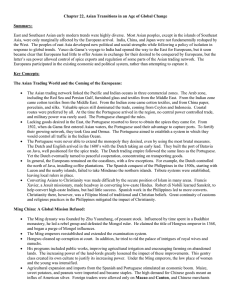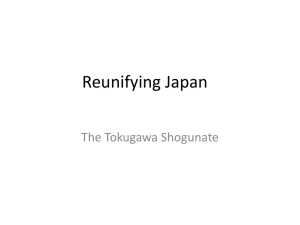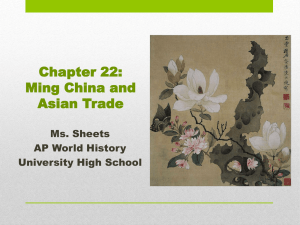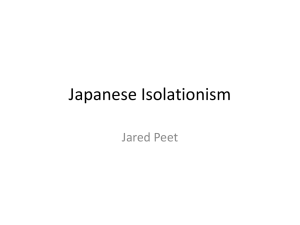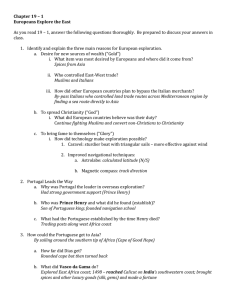Asian Transitions
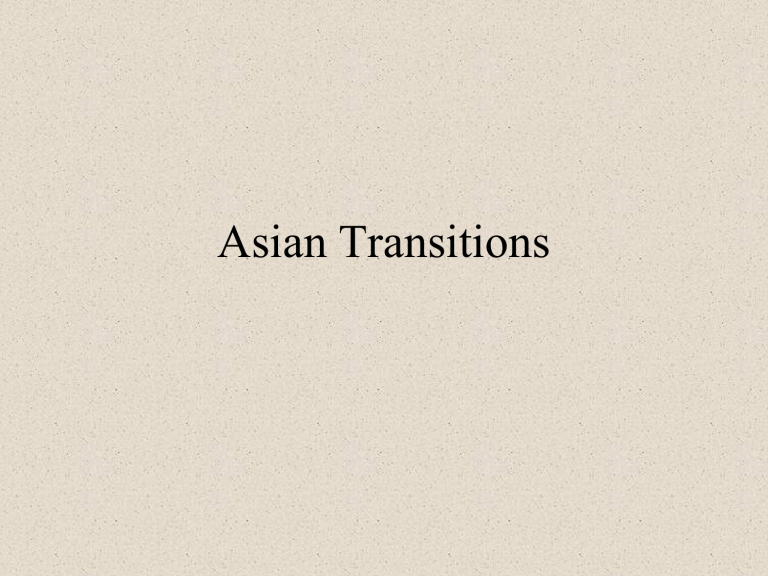
Asian Transitions
Introduction
• Columbus’ expedition considered a failure b/c he didn’t reach the
Indies and open a trade route to Asia. Prompted the Portuguese to continue around Africa though…and they reached Asia (India-
Calicut). They were supported by the sultan of Malindi who showed them the route to India.
• Vasco da Gama (Portuguese) reached India in 1498 and was in for a rude shock
• The local merchants Hindu and Muslim were not interested in poorly constructed and manufactured European goods (glass/ textiles/ cast-iron pots). They also were not receptive or open to conversion to Christianity. All da Gama had to offer for trade purposes (for the spices and fine textiles) was the emergency bullion he had, which didn’t go that far.
• Found themselves in an unequal trade relationship! What to do?
Mercantilism taught that only a finite amount of wealth and power existed and if you send out your wealth (bullion) another country would become powerful at your expense! Therefore the Portuguese turned to naval power and conquering to attempt to establish their monopoly over Asian trade
Vaco da Gama's passage to India
©
Asian trading and Europe
• Indian Ocean Basin had been a hot bed for trade from ancient times! In fact trade had been going on for thousands of years and had fallen into a peaceful exchange.
• The Asian sea trading network:
Arab zone: glass, carpets, and tapestries (Red sea /Persian gulf)
Indian zone: cotton textiles (India)
Chinese zone: paper, porcelain, and silks (China)
• Highest demand/ prices was for spices! These expensive spices came mainly from Ceylon (Indonesian archipelagos). Items trade both long and short distances!
• Coastal routes preferred b/c they hugged the coast and made it was easier to navigate and mother nature was/is unpredictable.
• Europe attempted to regulate Asia trade because
1. No central control over it (no ruler or country totally controlled)
2. Military force was absent from commercial exchanges
Trading Empire
• Portuguese decided to take by force what they couldn’t get through fair trade: mercantilism
• They had superior ships and weaponry –sea warfare
(except for the Chinese). Portuguese had the element of surprise!
• Da Gama returned in 1502 he created force ports on
African and Indian coasts with a tribute system. 1509 defeated Egyptian and India fleet off Diu
• Portuguese couldn’t control Asian trade via just sea patrols so they started to capture towns and build fortresses at strategic points (Ormuz,1510 Goa, and Malacca 1511).
Ports were naval bases, ports, and factories.
• Goal to establish a Portuguese monopoly (cinnamon) over
Asia trade, but never happened! They wanted to take goods and sell at high prices for large profits.
• Tried to impose licensing system on merchant ships trading in their controlled area-not successful
Portuguese Vulnerability
• Managed to control the flow of the spices trade for a few decades then fell from power. Never controlled key condiments like pepper and cinnamon!
Poor military discipline and corruption among officials became a problem
• Had severe punishments: cutting off hands of rival trades and ships caught going against their monopoly!
Led to more resistance to
Portuguese dominance!
• Dutch and English were easily able to come in and conquer Portuguese in
Asia. Dutch short term victors. Dutch captured Malacca and built a new port, Batavia in 1620 on the island of Java. Dutch focused on a monopoly over a few spices rather than all Asia trade.
• Dutch trading empire: fortified towns, factories, warships, monopoly of limited spices! To regulate cloves, nutmeg, and mace they’d uproot plants. Remove or wipe out island people that grew plants without Dutch knowledge/ supervision.
• Great profits Dutch got was through working with the people peacefully!
Tried to control pepper, but couldn’t. Engaged in actions to gain control.
Money from fees charged for transportation of products from one area of
Asia to another or goods sold in Europe at inflated prices.
European Tribute in Asia
• Inland areas of Asia able to resist European advances b/c of their superior numbers!
• Were in a secondary position to local leaders. Some went inland-Dutch in Ceylon and Java (discovered great place to grow coffee).
• Spanish –Treaty of Tordesillas in 1494- began conquering the northern Philippines (1560’s).
Southern Mindanao kingdom was Muslim and wanted to resist Christian dominance.
• Really made little attempt to interfere with the daily lives of people of Asia
• If tribute quotas met European powers were happy.
• Tribute required peasant labor, but understood they still needed subsistence farming.
Spreading the faith
• Spread of Roman Catholic Church-Islam and many older existing religions in Asia
• Francis Xavier-mission to all-many untouchables attracted to the message. Upper class however were not. They didn’t’ want to lower themselves to worship with untouchables!
• Robert di Nobili-focused on conversion of upper caste Hindus (unsuccessful). Adopted to their ways and gave up meat eating. Eventually sent back to Rome!
• Those that did accept merged their local beliefs with Christianity to produced something new
• Most success in the northern Philippines which had not been previously exposed t a work religion
•4
Robert di Nobili
Zhu Yuanzhang
Painting by Xuwei
Ming 1368-1644
• Zhu Yuanzhang overthrew the Yuan (Mongolian) dynasty in
China. He had suffered greatly at Mongol rule: his parents and 2 brothers died in a plague in 1344 and he had to beg for land in which to bury them! He moved into a monastery to survive and while there started to learn about the rebel movement. He left the monastery and soon became a leader!
He fought other rival rebels and eventually then Mongol rule.
He declared himself, Hongwu emperor in 1368 and started the Ming dynasty.
• He immediately moved to repel Mongolian influence in
China. He even brought back the civil service exams…which the Mongols had stopped. The exams became even harder! 2 level
-county level: 2 out of 3 yrs –low level bureaucrats
-Imperial: every 3 yrs –highest bureaucrats
• The test took days! Confined to a cubicle and watched. Very competitive –4000 tried out for only 150 degree! Success granted rise in status.
Hongwu’s Reforms
• Being a peasant he was suspicious of the scholar-gentry and dependence upon it. He placed limits on power and influence of bureaucrats. Abolished chief minister position (held lot of influence) and began public beating for those bureaucrats deemed incompetent or corrupt. These public bare bottom beating usually resulted in deaths because the wounds were so severe.
• Hongwu also tried to limit the influence of wives by attempted to make sure they were only from humble families (didn’t work). He wanted to make sure these women didn’t try and give their relatives special privileges at court.
• Sought to limit the number and power of eunuchs
• Made sure all potential rivals were exiled and that they couldn’t participate in politics
• Also tried to improve the lives of peasants by: public works projects, giving lands to peasants who cultivate it, and lowering the demand on conscripted labor, and he also promoted silk and cotton production to supplement peasants’ income. Didn’t work…large gentry households allowed peasant to take out loans against their lands and when they couldn’t pay they took possession of the lands and turned the peasants into tenant farmers.
Social/ Age of Growth
• Confucian values of knowing your place in society still important.
Student beheaded for questioning teacher and he head was hung on a pole at the entrance of the academy to sent a warning to other students!
Student protests went underground.
• Women were also subordinate. They were expected to be subordinate to father and later husband. Women tried to influence men around them by their positions as: wife, mother, mother in-law, concubine, or even a courtesan. Importance placed still o having male children!
• Population and economic boom: silver from the Americas brought in to buy luxury goods for western Europe AND new crops like corn, sweet potatoes, and peanuts supported population growth. State made revenue off taxes (tax collected in just silver!)
• 80-90 million in the 14 th century to 120 million in the 16 th to 300 million in the 18 th !!!
• Canton is where Europeans were officially able to do business in China.
• Merchant class rose and so did the wealth of China-art (more colorful -
Xuwei) and literature. 1 st Chinese novels: The Water Margin, Monkey, and The Golden Lotus.
Age of Expansion
• Ming rule drove out beyond China and China began exploring and expanding! Emperor Yunglo launched a series of expeditions
1405-1423 under admiral Zhenghe. He traveled around Asia, the
Indian Ocean Basin, and all the way to Africa.
• Initial fleet: 62 ships and 28,000 men compared to Columbus’ 3 ships and da Gama’s 4-later had 150) The Chinese had the power to expand on a global scale, but did not! Rivalry between
Confucian scholars and Zhenghe!
• 1390 1 st edict aimed at limiting Chinese overseas commerce issued
Ming war fleet decline and was restricted.
• Christian missionaries soon followed the merchants, but had little success in Asia other than the Philippines. Tried to impress the bureaucrats with their knowledge: Matteo Ricci and Adam Schall
(Jesuit scholars). But some hostile to the “barbarians” and felt embarrassed by their corrections.
Zhenghe travels
Emperor Yunglo
Ming Decline
• Mediocre and incompetent leaders
• Decades of unchecked official corruption
• Thousands of eunuchs that dominated the Forbidden City
• Public works projects fell into disrepair
• Floods, drought, and famine soon happened
• Peasants ate bark off trees, wild geese excrement, sold children into slavery, and even in some cases reverted to cannibalism!
• Local landlords took advantage of desperate peasants and built huge estates! Poor and displaced fled, turned to banditry, and finally open rebellion!
• Foreign threats-northern nomadic peoples (Manchus) and even
Japanese pirates!
• 1644 Ming dynasty fell: emperor Chongzhen tried to kill his daughter (but messed it up), wife killed herself, then he hanged himself to avoid capture by rebel soldiers.
Fending off the West
• 3 strong military leaders restored power to Japan after years of daimyo (warlords rulers of 300 small states following the civil war and disruption of the Ashikaga
Shogunate) stalemates.
• Nobunaga-he was from a minor warrior household and was a remarkable military leader…one of the first to use firearms. He also liked the element of surprise. 1573 Nobunaga deposed of the last Askikaga Shoguns (of course only ruled in name) By 1580 he unified centrally and pushed to fight the western daimyos. Killed in a fire in a temple
• Toyotomi Hideyoshi-one of Nobunaga’s commanders punished those who betrayed Nobunaga and moved to continue his plan. He was a great military leader as well as diplomat. He created alliances and victories that enabled him to become the master of Japan by 1590. He wanted to continue expanding and create an empire…wanted to take over China and India! He attacked Korea in
1592 (failed) and 1597 (Hideyoshi died though).
• Hideyoshi son was to take power after his death, but it turned into warfare and
Tokugawa Ieyasu ended up the victor. He stopped Hideyoshi’s overseas campaigns to focus on consolidating power in Japan. In 1603 the emperor granted Ieyasu the title of shogun which formally started the Tokugawa shognuate. Tokugawa held power in central Japan and closely watched the daimyos who were allowed to retained their domains if they pledge person allegiance to the shogun. This marked a end to civil wars in Japan and the beginning of political unity.
Nobunaga
Toyotomi Hideyoshi
Tokugawa Ieyasu
European Challenge
• 1543 Portuguese made it to Japan. They started to trade goods from India and China for silver, copper, pottery, and lacquerware.
They also brought European goods such as guns, printing press, and clocks. Guns revolutionized Japanese warfare and allowed for
Nobunaga to take power!
• Christian missionaries soon followed. With the militant Buddhist always opposing the government Nobunaga turned to Christians.
He allowed them to preach and soon hundred of thousands became
Christian. But after Nobunaga was murdered things changed!
Hideyoshi wasn’t crazy for the new religion and by this time the militant Buddhist sects were well under control. Plus some new
Christians refused to obey when they felt it conflicted with their religious view! Soon Hideyoshi felt that after missionary work the
Europeans were going to try to invade so something had to be done!
Japan’s Isolation
• Due to fears about European intentions and the problem created by merchants and Christians to the social order Japan started to restrict
European activities starting in 1580s. Hideyoshi order Christians missionaries leave and by 1590s he started actively persecuting
Christian missionaries and converts. Ieyasu officially banned the religion in 1614.
• Christian missionaries who refused to leave were hunted down and executed or expelled. Those who refused to recant were imprisoned, tortured, or even executed. Rebellions broke out where thousands of converts tried to fight against local daimyos for religious freedom, but they were suppressed.
• This led to the isolate of Japan. Merchant only allowed to trade in specific cities and by 1630s Japanese only could trade and sail within their own waters. Many western nations didn’t want to risk or want to trade with the Japanese. Imports were restricted…no western books…didn’t want Christian ideas to get back into the country.
• Almost completely isolated! Tokugawa shogunate consolidated powers. Later the school of National Learning developed.
Global Connections
• Most people in Asia little affected by Europeans!
• New trade routes to Asian networks developed with the establishment of new trading centers like Goa, Calicut, and
Batavia. Decline of Muslim merchant centers.
• Europeans decided better to adapt to existing systems in Asia rather than fighting (sea warfare)
• Contact between Europe and Asia had existed for years so no new disease spread like in the Americas. Instead Europeans got sick-
Asian malaria and dysentery
• However Asia benefited from crops of the Americas
• China got lots of silver!
• Western surge in exploration and commercial expansion touched most of Asia peripherally (esp. East Asia)
• Strong Chinese and Japanese leaders limited European commercial activity and Christianity
• Failed to keep pace with European innovation though

